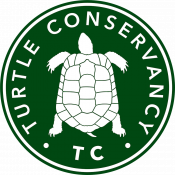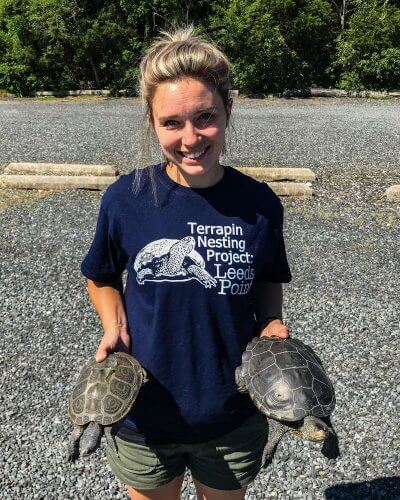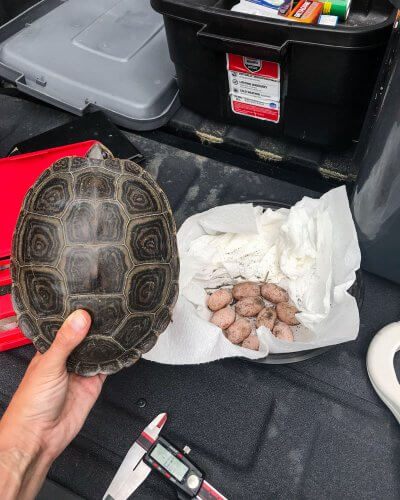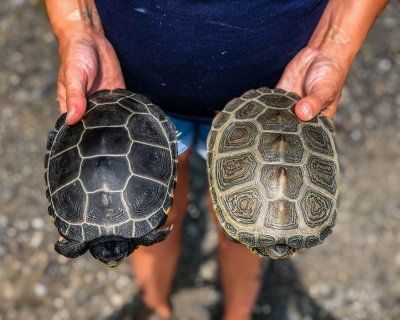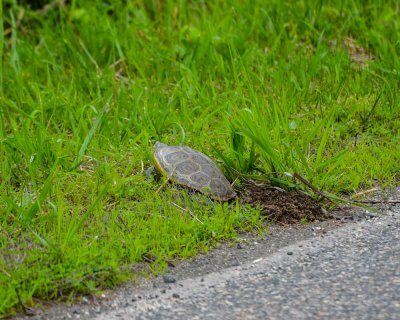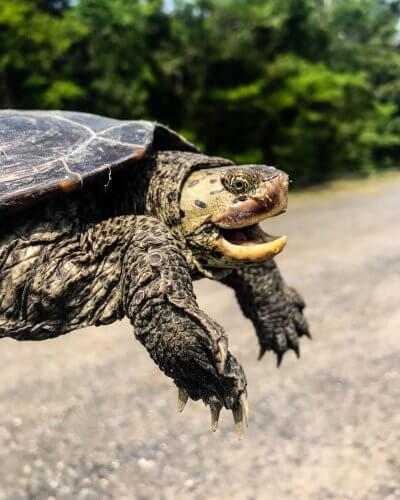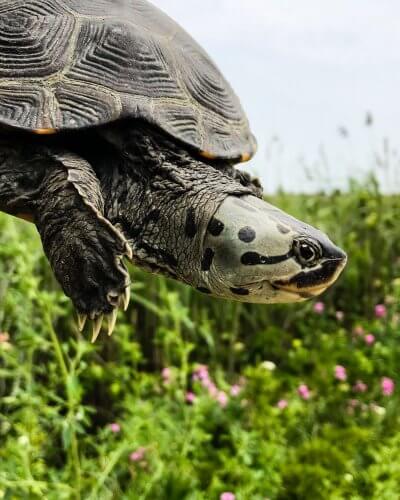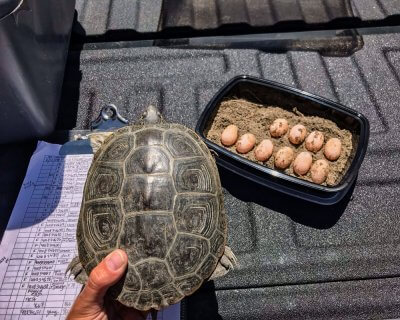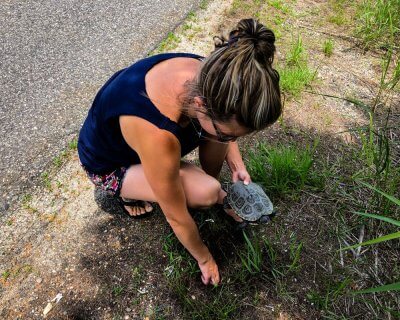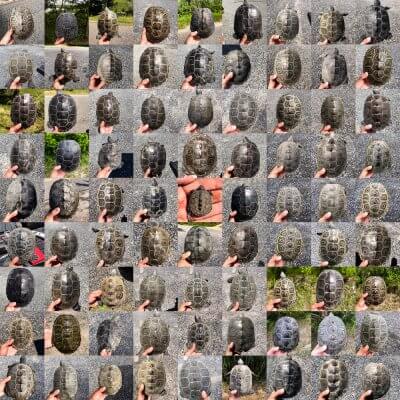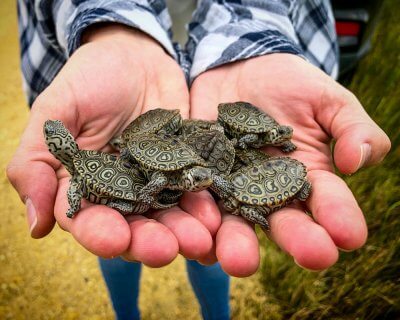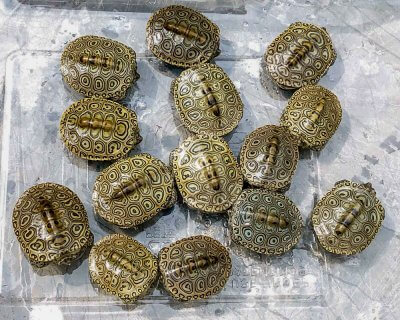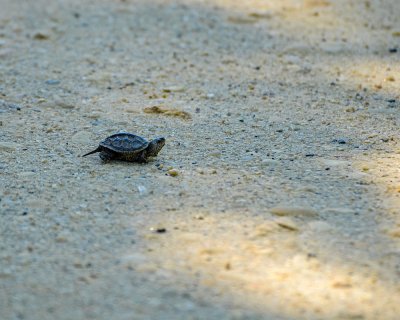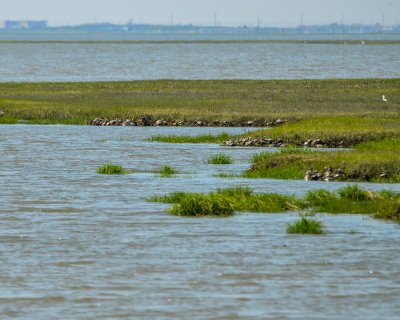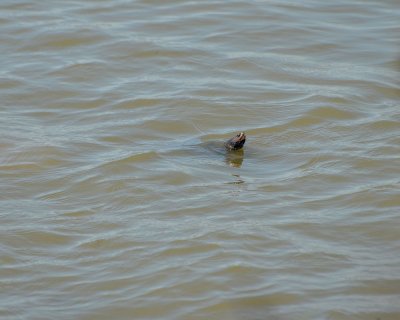Terrapin Conservation Initiative
Protecting and sustaining a Malaclemys terrapin terrapin population
Project Summary
Since 2017, theTurtleRoom’s Casey and Chris Leone have led the Terrapin Conservation Initiative (TCI) in southeast New Jersey as part of a statewide research and conservation network to protect the Northern Diamondback Terrapin (Malaclemys terrapin terrapin). Northern Diamondback Terrapins live exclusively in brackish water and inhabit the many miles of coastal salt marshes and estuaries along the Atlantic Coast. For decades, Diamondback Terrapins were considered a game species in New Jersey and had an open harvesting season. This practice ended in 2016 when an executive order was signed that changed the status of the species to non-game. However, this species still faces numerous threats such as habitat loss, illegal trapping, nest predation, mortality from being drowned in crab traps, and road mortality. The goal of the TCI is to support the local population by excavating and incubating nests and releasing the offspring back into the habitat. Along the way, we hope to gain a better understanding of the population in the sites, such as male to female ratio, percentage of hatchlings making it to adulthood, and ways to decrease nest predation.
In the future, we hope to expand our research to learn more about sex ratios and migrations from season to season, but we require funding to do this. The budget for 2020 season is approximately $5000. Funds would go towards the purchase of permits, incubators, PIT tags, other equipment, and travel costs. Future expansion could include the purchase of kayaks and trapping equipment. We hope to contribute valuable research information as part of a larger research and conservation effort along the Atlantic Coast to help protect this vulnerable species. Gravid female terrapins travel long distances on land to search for suitable nesting sites. Unfortunately, this often leads them to cross busy roads since nesting season coincides with summer shore traffic. Many terrapins are hit and killed by cars each year, and on some roads the mortality rate is close to 100%. The TCI involves conducting 24/7 road patrols to look for gravid females and observe nesting behavior and predation events. While patrolling, we also look for suspicious activity and report illegal poaching to the New Jersey Division of Fish and Wildlife. Every terrapin encountered is weighed and measured to collect data for the state. Specific guidelines and protocols are followed to ensure the safety of every adult, hatchling, and nest observed. Adult female terrapins are PIT tagged with a specific identification code that is documented and stored in our database and reported to the state to help with long-term research as well as to assist with poaching enforcement and confiscation efforts.
In addition, since the start of the project, hundreds of nests have been documented that were completely predated from crows, gulls, fox, etc. Each nest is excavated to search for eggs that are still viable. We then artificially incubate each clutch and release the hatchlings at the end of the season. Each hatchling is notched with a code dedicated to the year they hatched so they can be identified when they reach sexual maturity and start nesting. The valuable data collected from the Terrapin Conservation Initiative is a key component to securing the long-term conservation goals of the imperiled Diamondback Terrapin in New Jersey before it is too late. Learn even more at the website dedicated to the Terrapin Conservation Initiative.
Natural History
Northern Diamondback Terrapins (Malaclemys terrapin terrapin) are found along the east coast from Cape Cod, Massachusetts to Cape Hatteras, North Carolina. Males range from 4 to 5.5 inches (10-14 cm) in carapace length, while females are larger and range from 6 to 9 inches (15-23 cm) in length. Males also have long, thick tails while females have short, narrow tails. Coloration varies but the carapace is typically brown, gray, or black with diamond-shaped patterns on the scutes which give the species its name. The plastron is yellow or greenish in color. The skin is light or dark gray with black markings while the upper mandible is light in color. Diamondback Terrapins are most active at high tide and feed on crustaceans and mollusks such as green crabs, fiddler crabs, blue crabs, snails, mussels, and marine worms. Terrapins brumate during the winter and bury themselves in the soft mud at the bottom of marshes, tidal creeks, and bays. They emerge in early spring and mating occurs soon after. From early June to mid-July, females leave the water to find suitable nesting sites in sandy upland areas that are above the high tide line. Clutches of 8-12 eggs are laid and hatch in 61-104 days depending on how warm the soil is.
This species exhibits temperature based sex determination where the warmer the soil is, the more females are produced. Only around 1-3% of the eggs laid actually produce a hatchling, and success rates of young reaching adulthood are also low. Hatchlings are commonly predated by seagulls, crows, raccoons, and other predators. Males reach sexual maturity between 5-8 years of age while females do not reach sexual maturity until they are 9-10 years in age. From the mid-1800s early 1900s, Diamondback Terrapins were hunted so extensively that they almost faced extinction. Terrapin stew was a popular delicacy in the U.S. and terrapins were exported to several European countries before it became less popular. Diamondback Terrapins and turtles in general remain a popular food item in the Asian food market, and many terrapins are illegally shipped to Asian countries even in recent years. Legal terrapin harvesting continued well into the 21st century before most states finally banned the practice, but illegal harvesting and trading remains an issue.






